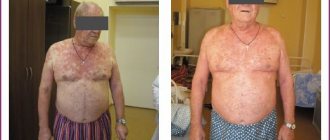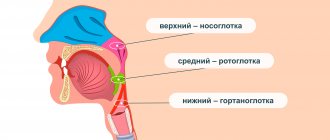Coughing is an innate human reflex, and not just a respiratory symptom of the disease. When a person coughs, he cleanses his respiratory tract from foreign bodies that interfere with breathing - food, dust, and when he gets sick - from sputum, mucus, blood, pus. If the cough does not stop for more than two months, the condition is usually called chronic. After eight weeks of chronic cough, you should definitely consult a doctor for examination, since this condition can be an indicator of many serious diseases.
Comparison criterion 1 - quality and quantity of sputum
Dry (non-productive) cough
It is not accompanied by sputum production and does not bring relief.
This cough can be a symptom of the following diseases:
- pharyngitis,
- laryngitis,
- "lecturer's" laryngitis,
- tracheitis,
- bronchitis.
Sometimes, depending on how a dry cough sounds, you can determine which disease it is a symptom of. In the case of the diseases mentioned above, the doctor may prescribe the use of a syrup that can transform a dry cough into a wet one. A not too intrusive dry cough caused by drying out of the pharyngeal mucosa or accumulation of mucus at the entrance to the larynx most likely indicates a disease such as pharyngitis. With this, the doctor may prescribe inhalations, warm drinks and lozenges and lozenges to soothe a sore throat.
Wet (productive) cough
Accompanied by sputum production. This is a viscous liquid that is produced by the mucous membranes of the respiratory tract: lungs, bronchi, throat, nasopharynx. Microbes and their metabolic products are removed from the human body with sputum.
- Yellow discharge can be a symptom of sinusitis, bronchitis or pneumonia. Sometimes a yellow tint is given by pus, which is mixed with sputum.
- White, curd-like sputum may indicate fungal diseases in the respiratory tract.
- Sputum that is white but watery in appearance indicates a viral infection or chronic respiratory disease.
- Brown discharge is a symptom of viral or bacterial diseases accompanied by inflammation. It can appear with pneumonia, bronchitis and even with a common cold.
To cure a wet cough, it is necessary to remove accumulated phlegm from the lungs and bronchi. In this case, doctors prescribe expectorant or sputum-thinning syrups and tinctures for adults.
It is important to know!
It is contraindicated to treat a wet (productive) cough with antitussive drugs, that is, those that suppress the cough reflex.
Differential diagnosis of cough in children and its treatment
Cough is a protective mechanism for cleansing the bronchi and trachea. It occurs when exposed to “fast” or irritative receptors of mechanical and chemical stimuli and to “slow” C-receptors - mediators of inflammation. Rare cough shocks are physiological, they remove accumulation of mucus from the larynx; healthy children “clear their throat” 10–15 times a day, more in the morning, which should not alarm parents.
In the differential diagnosis of cough, it is very important to distinguish between its temporary characteristics: acute cough; persistent cough lasting three or more weeks after an acute episode; recurrent, occurring periodically; long persistent cough.
Types of cough
Acute cough . Characteristic of acute viral catarrh of the upper respiratory tract, as well as inflammation in the larynx (laryngitis, croup), trachea (tracheitis), bronchi (bronchitis) and lungs (pneumonia). When the respiratory tube is damaged, the cough is initially dry, unproductive - it does not lead to the discharge of sputum and is subjectively felt as intrusive. With laryngitis and tracheitis, it often acquires a barking character and a metallic overtone. A dry cough accompanies a sore throat with laryngitis. With pneumonia, the cough is usually wet from the first hours of illness and is often described as deep.
A wet cough is characteristic of a full-blown picture of bronchitis; its shocks end with the discharge of sputum (in small children this is perceived aurally), appearing again when it accumulates. The discharge of sputum is subjectively perceived as relief.
In the differential diagnosis of an acute cough, it is important to verify its connection with infection (fever, the presence of catarrhal syndrome). In a child with signs of acute respiratory viral infection (ARVI), hoarseness and difficulty in breathing indicate damage to the larynx with a possible threat of asphyxia (croup). Moist rales in both lungs indicate bronchitis: in older children they are usually large- and medium-bubble, in small children they are often small-bubble, which allows a diagnosis of bronchiolitis.
The key task in the presence of signs of acute respiratory infections is to exclude pneumonia - most often, wheezing is absent in the lungs or is heard over a limited area of the lung, where a shortening of the percussion sound and/or a change in the breathing pattern is also detected. The nature and strength of the cough does not indicate the etiology of pneumonia. An exception is the stokato cough in children with chlamydial pneumonia in the first months of life: “dry”, abrupt, ringing, followed by attacks, but without reprisals, accompanied by tachypnea, but not a febrile reaction.
Spasmodic cough is characteristic of bronchial asthma, and in children of the first years of life - with acute obstructive bronchitis or bronchiolitis. In these forms, wheezing is accompanied by prolongation of exhalation, which indicates the presence of bronchial obstruction. A spasmodic cough is usually unproductive, intrusive, and often has a whistling overtone at the end.
In the event of a sudden onset of cough, including spastic cough, without signs of acute respiratory viral infection, you should think about a foreign body in the respiratory tract, especially in a child who has not previously had a spastic cough. It is characterized by an attack of whooping cough - obsessive, but not accompanied by reprises. This cough may last for a short time; when a foreign body moves into the smaller bronchi, the cough may stop. A foreign body is often accompanied by swelling of one lung, over which weakening of breathing and, often, whistling exhalation are heard; with such symptoms, bronchoscopy is indicated.
Prolonged cough (more than 2 weeks). It is observed quite often, usually after acute bronchitis. Most often, it is associated not so much with the inflammatory process as such, but with post-infectious hyperproduction of sputum and, often, with hypersensitivity of cough receptors. When deciphering such a cough, it is important to take into account the child’s age.
In infants after obstructive bronchitis, the persistence of hypersecretion of mucus with an increase in the cough threshold causes a rare wet cough for 4 weeks or more; its distinctive feature is the presence of “hoarseness” - bubbling sounds in the chest, audible at a distance, which disappear after coughing and reappear as sputum accumulates. Sputum from the trachea and larynx in infants is evacuated by more rare cough shocks, when the lumen of the bronchi is almost completely blocked. In such children, coughing with pressure on the trachea (or with a spatula on the root of the tongue) is difficult to induce. The cough associated with hypersecretion gradually subsides, both in frequency and intensity.
However, cough associated with habitual aspiration of food due to dysphagia, the most common cause of prolonged cough in infants, both breastfed and artificially, should be excluded. Establishing the fact of dysphagia usually requires monitoring the feeding process, since not every mother pays attention to the connection between cough and food intake. In addition to “choking” and “coughing” during food, food aspiration is characterized by the appearance of wheezing, which quickly disappears or changes its location and intensity after a cough impulse. Chest radiography in such children usually reveals darkening or intensification of the pulmonary pattern in the upper lobes.
Cough when eating is also observed in the presence of a bronchoesophageal fistula; its distinctive feature is the separation of copious frothy sputum; the presence of this symptom requires a contrast study of the esophagus and esophagoscopy.
Children who, in addition to dysphagia, have gastroesophageal reflux are characterized by coughing attacks during sleep. Finding a wet pillow confirms this diagnosis.
A lingering cough in children of early and preschool age is often caused by the flow of mucus into the larynx from the nasopharynx with long-term nasopharyngitis, adenoiditis, and adenoid hypertrophy; Unlike cough with bronchitis, it is not accompanied by wheezing in the lungs, often has a superficial character and disappears when the process in the nasopharynx is treated. A prolonged episode of bronchitis with cough lasting 2–4 weeks is common in preschoolers with recurrent bronchitis.
A prolonged dry cough in school-age children and adolescents, which can last up to 6 weeks, is not uncommon with tracheitis or tracheobronchitis, which develops with certain respiratory viral infections (RS, rhino-, parainfluenza viruses). It is often painful, paroxysmal, and the attack ends with the discharge of a lump of dense mucus (fibrinous deposits). Special studies, however, have shown that among children of this age who have been coughing for more than 2 weeks, 25% or more experience whooping cough in their characteristic atypical form - without pronounced paroxysms and relapses.
This course of whooping cough is typical for both incompletely vaccinated children and children who received 3 vaccinations and revaccination at 18 months. The fact is that pertussis immunity gradually fades away and after 5–6 years—by school age—most vaccinated people become susceptible to this infection. Its atypical course in them contributes to late diagnosis (if it was carried out at all) and the spread of infection and infection of infants who have not yet received all vaccinations.
A lingering cough in adolescents with whooping cough is characterized by the absence of wheezing in the lungs; it usually does not intensify and does not acquire a specific character, as in those who have not been vaccinated. Sometimes, however, it is possible, by pressing with fingers on the trachea or with a spatula on the root of the tongue, to cause a semblance of a whooping cough shock with protrusion of the tongue, redness of the face, less often with a typical reprise. A bacteriological diagnosis of whooping cough in these children is rarely possible; it is more reliable to determine in the blood of antitoxic antibodies, which in sick people, unlike vaccinated ones, are present in high titers.
Recurrent cough . It is typical, first of all, for patients with bronchial asthma - this is one of the frequent complaints of parents of children whose asthma diagnosis has not yet been established. The cough that accompanies almost every episode of acute respiratory viral infection is also characteristic of recurrent bronchitis - it is usually wet, lingering, its duration exceeds 2 weeks, it is not accompanied by obvious signs of bronchospasm, which, however, is often detected during the study of pulmonary function (PRF) (test with bronchodilators).
With recurrent obstructive bronchitis (ROB) in children under 3–4 years of age, a cough—wet or “spastic”—occurs against the background of ARVI, usually in the presence of fever and catarrhal syndrome. Unlike cough in bronchial asthma, it does not have the character of an attack. However, by the type of cough, these two forms can hardly be distinguished, since cough and obstruction due to ARVI are the most common type of exacerbation of bronchial asthma, especially in young children. For many of them, the diagnosis of ROB eventually “flows” into the diagnosis of asthma, if such episodes are repeated more than 3-4 times or if periods of coughing are associated not with ARVI, but with an allergen, physical activity, cold air, or if they occur for no apparent reason at all - as a consequence of increased inflammatory changes in the bronchial mucosa.
Long, persistent cough . It is observed in chronic diseases of the respiratory system, which immediately distinguishes it from the types of cough described above. Of course, it can intensify or weaken at certain periods of time, but it is fundamentally important that the child coughs almost constantly.
A wet, persistent cough is observed in most suppurative lung diseases, accompanied by accumulation of sputum. The cough is often especially severe in the morning, and becomes less frequent after sputum has been removed. A cough that is “deeper” to the ear is typical of bronchiectasis; with defects of the bronchial cartilage (Williams–Campbell syndrome), it may have spastic overtones.
In cystic fibrosis, the cough is often intrusive and painful due to the viscosity of the sputum, often accompanied by signs of obstruction. The diagnosis is not difficult in the presence of other manifestations of cystic fibrosis - weight loss, polyfecal matter, tympanic fingers, etc., however, there are milder forms of this disease, so a study of sweat electrolytes is indicated in all children with a persistent cough.
A persistent dry cough with a change in voice may indicate laryngeal papillomatosis. A dry cough accompanied by shortness of breath, chest deformation, signs of cor pulmonale, and tympanic fingers is characteristic of fibrosing alveolitis.
Psychogenic cough deserves special attention , for which a persistent cough is also typical. This is usually a dry cough with a metallic tint, which is observed only in the daytime and disappears during sleep; its distinctive feature is regularity and high frequency (up to 4-8 times per minute), stopping during eating and talking. A psychogenic cough usually occurs as a reaction to stressful situations in the family and school, then becomes habitual; it often begins during an acute respiratory infection, quite quickly acquiring the character described above. In some children, this cough has the character of a tic or a manifestation of obsessive-compulsive disorder (Gilles de la Tourette syndrome).
Young children often cough when stressed, usually to achieve their goals; The cough intensifies before and during the doctor’s examination, stopping at the end of it (relieving “anticipation stress”). A new coughing attack can be provoked by touching on a topic that is unpleasant for the child (whims, keeping a daily routine) or even by simply starting an abstract conversation, without paying attention to the child. The reason for the strengthening of the cough reflex in a child may be increased anxiety of parents and concentration of their attention on respiratory symptoms. Such children require an in-depth examination to exclude organic pathology, sometimes trial treatment with antispasmodics and steroid aerosols.
Some types of cough differ in nature.
Bitonal cough (low, then high tones). Occurs with tuberculous granulations from a lymphobronchial fistula, sometimes with foreign bodies in large bronchi. Is an indication for bronchoscopy.
Cough when taking a deep breath . Accompanied by pain, indicates pleural irritation; it goes away after pain relief (codeine, Promedol). The same cough during restrictive processes is associated with increased lung rigidity (allergic alveolitis). Taking a deep breath also causes a cough in children with asthma - it occurs as a result of bronchial hyperreactivity; shallow breathing is an integral part of a number of physical therapy (physical therapy) systems used to treat asthma.
Night cough . Characteristic of bronchial asthma, it usually occurs closer to the morning due to increased bronchospasm; It often indicates an allergy to the feathers in the pillow. In some children, nocturnal cough is the equivalent of asthma, so these children should be assessed accordingly. Night cough is also observed with gastroesophageal reflux, while older children complain of heartburn. Quite often, night cough occurs in children with sinusitis or adenoiditis due to mucus entering the larynx and drying of the mucous membrane when breathing through the mouth.
Cough during exercise is a sign of bronchial hyperreactivity and is observed in a significant proportion of patients with bronchial asthma.
Cough with syncope - short-term loss of consciousness - occurs due to a decrease in venous inflow with an increase in intrathoracic pressure and, as a result, a decrease in cardiac output; The condition is benign and does not require treatment other than antitussives.
Cough treatment
The fight against cough has been fought by humanity since time immemorial - even now, when we know so much about cough, both parents and many pediatricians consider cough as an undesirable symptom and strive to stop it. Complaints about cough and persistent requests from parents to treat the cough are apparently connected not only with the fact that cough is a clear sign of a child’s ill health. Subjectively, the cough of a person nearby or in a close environment is perceived as an irritating, unnerving phenomenon. Hence the desire to stop coughing at all costs.
What new does the modern understanding of the nature of cough give us? Firstly, that there are several causes of cough and that it only makes sense to suppress coughs caused by “dry” inflammation of the mucous membrane of the respiratory tract - for example, with laryngitis, as well as coughs associated with irritation of the pleura. In those cases when the cough leads to the removal of sputum, suppressing it is impractical and even dangerous. It is important to explain to parents that coughing is a protective reaction aimed at clearing the airways in conditions of hypersecretion of mucus and reduced efficiency of mucociliary clearance. In practice, treatment of cough as such is required only in rare cases when it significantly disrupts the patient’s life.
Antibiotics . First of all, it is important to understand that the presence of a cough in itself is not a reason for antibiotic therapy. It is carried out only in cases of proven bacterial infection of the upper respiratory tract (otitis media, sinusitis, streptococcal tonsillitis) and lung damage (pneumonia, including chronic pneumonia, cystic fibrosis, lung malformations). With regard to acute bronchitis, it has been proven that antibacterial therapy is justified only for mycoplasma and chlamydial etiology (10–15% of the total number of bronchitis, more often at school age), while the majority of bronchitis, including obstructive ones, are viral diseases.
Antibacterial treatment of whooping cough, including those that occur in the form of a prolonged cough with an early onset (in the first 7–10 days), can interrupt clinical manifestations. At a later date, it is difficult to expect a great effect from antibiotics, but such treatment stops the release of bacilli within 2-3 days, so it is completely justified from an epidemiological point of view. Erythromycin (50 mg/kg/day) and clarithromycin (15 mg/kg/day) for 10–14 days or azithromycin (10 mg/kg/day) for 5 days have proven effectiveness.
Data on the use of the local antibiotic fusafungin (Bioparox) after tonsillectomy and adenotomy operations, as well as for adenoiditis and ARVI, have been published in the literature, primarily by otolaryngologists. The drug also has a local anti-inflammatory effect. Taking into account the fact that during ARVI, pneumococci and Haemophilus influenzae multiply, its use may be justified in children at risk. However, for proven bacterial infections (streptococcal tonsillitis, otitis media, etc.), Bioparox does not replace systemic antibiotics.
Treatment of laryngitis . When a barking cough accompanies laryngitis, it is customary to inhale hot steam - for example, in a bathroom with an open hot water tap. However, this type of treatment has been proven to be ineffective for both croup and bronchitis. A meta-analysis of numerous studies on the treatment of croup has shown that intramuscular dexamethasone (0.6 mg/kg) or, in milder cases, inhaled budesonide (Pulmicort) is most effective in preventing the development (or progression) of laryngeal stenosis. These remedies also help to quickly stop coughing.
Antitussives and expectorants . A dry cough is theoretically an indication for the prescription of antitussive drugs, but in most cases of ARVI, after a few hours it gives way to a wet cough, in which these drugs are contraindicated. As antitussives in children, mainly non-narcotic drugs are used - butamirate, dextromethorphan, glaucine, oxeladine, pentoxyverine (
). A recent study showed, however, that a spoonful of buckwheat honey at night calmed nocturnal coughs in children 2–18 years old with acute respiratory viral infections at least as well as a dose of dextromethorphan. And milk with alkali, tea with jam, etc. “homemade” remedies soothe a barking cough with pharyngitis (sore throat) no worse than “antiseptic” lozenges or sprays. This gave WHO grounds to recommend only home remedies for coughs.
In cases where it is necessary to prescribe medications for pharyngitis, taking into account the fact that most drugs contain antiseptics that disrupt the biocenosis of the oral cavity, it is preferable to use inhalations of Bioparox, a bacteriostatic agent that also has anti-inflammatory effects.
With a wet cough, cough suppression is unacceptable, so intervention is justified only if there is difficulty in sputum evacuation. The effectiveness of expectorants (mainly of herbal origin) is highly questioned; in addition, their use in young children may be accompanied by an allergic reaction and vomiting. However, these remedies (preparations of mint, marshmallow, licorice, oregano, coltsfoot, anise, wild rosemary, thyme, etc.) are widely used, which can be justified by their cheapness and safety (Table 2). But the use of expensive forms of such products, even if they contain extracts of exotic plants (Greenland herbs, quebracho, ivy leaves), cannot be justified. Rubbing the chest with preparations containing essential oils (eucalyptus, pine needles, etc.) and balms that are absorbed by the skin are no more effective than expectorants.
There are combination products on sale that contain both expectorants and antitussives (Bronholitin, Tussin, etc.) (). The idea of their creation is to make coughing less frequent, but more productive, which should reassure parents. These combinations also do not have proven effectiveness in children, but their testing in adult patients showed that such combinations do not improve sputum discharge, but significantly reduce respiratory function. It is unlikely that after this we can seriously recommend these remedies for practice.
Mucolytics . The use of mucolytics is more justified, especially in chronic diseases accompanied by an abundance of viscous sputum (cystic fibrosis, chronic pneumonia, bronchial malformations). The most pronounced mucolytic effect is that of N-acetylcysteine, which in pediatric practice is used mainly for cystic fibrosis and chronic pulmonary suppuration. However, it is difficult to classify it as an essential drug: for example, in the USA, acetylcysteine is used relatively rarely in patients with cystic fibrosis, with preference given to vibration massage. In the presence of purulent sputum in patients with cystic fibrosis, Pulmozyme (dornase-alpha) is indicated, which breaks down the DNA that accumulates in the sputum during the breakdown of cellular elements (
). The use of these agents is permissible only in conditions where postural drainage can be carried out after their administration.
Acetylcysteine should not be used in acute diseases, including bronchitis, since viscous sputum is rare in them, and there are no possibilities for postural drainage in case of “swamping” of the lung with liquid sputum, and this drug is approved from 12 years of age.
In acute and recurrent bronchitis, improvement of mucociliary transport is better achieved with the help of carbocysteine and ambroxol, the latter can be used both orally and as an aerosol in children receiving inhaled sympathomimetic for obstructive bronchitis.
Suppressing the cough that accompanies obstructive syndrome is also not an end in itself - the use of sympathomimetics, eliminating bronchospasm, also contributes to the cessation of cough (
). In case of status asthmaticus, accompanied by the formation of bronchial casts, attempts to use N-acetylcysteine can lead to increased bronchospasm.
Anti-inflammatory drugs . The use of locally acting inhaled corticosteroids (ICS) forms the basis of the treatment of moderate and severe bronchial asthma. Both metered dose inhalers (beclomethasone, budesonide, fluticasone) and nebulizer solutions with budesonide (Pulmicort) are used, especially in children under 3–5 years of age (Table 5). By suppressing inflammation in the bronchial mucosa, ICS help stop the cough it causes.
ICS can also be used for more severe respiratory infections, in which cough is associated primarily with an inflammatory process in the bronchial mucosa. In particular, the use of these drugs during the convulsive period of whooping cough reduces the frequency of coughing attacks and its intensity. ICS (together with sympathomimetics) can be used in the treatment of obstructive bronchitis (especially relapse of bronchitis) in young children. And although ICS does not shorten the duration of the disease, they have a positive effect on the severity of the acute period; There is also evidence of a reduction in the frequency of relapses of obstruction with continued treatment with ICS for 2–4 weeks after the end of the acute period. With prolonged cough due to tracheitis, ICS also often bring lasting relief.
The use of ICS, for obvious reasons, cannot be a “cough control” for most respiratory infections. An alternative to them is the non-steroidal anti-inflammatory drug fenspiride (Erespal - syrup 2 mg/ml), which, as a rule, does not have serious side effects. This drug improves mucociliary clearance, has activity as an antispasmodic and a blocker of H1-histamine receptors. In many patients, especially with recurrent bronchitis, including obstructive, chronic pathology, Erespal (at a dose of 4 mg/kg/day, in children over 1 year - 2-4 tablespoons per day) brings clear relief of cough and condition generally.
Treatment of psychogenic cough . Children with psychogenic cough are usually not helped by antitussives, expectorants, muco- and antispasmodics. Their treatment (after excluding a possible organic cause of cough) usually requires the prescription of antipsychotics, hypnotherapy and is carried out in conjunction with neuropsychiatrists. In the presence of compulsive-obsessive type disorders, there is experience in using slowly increasing doses of Clonidine. Treatment usually requires considerable time (many months), although in some cases the cough may suddenly disappear and begin again (in some cases in the form of obsessive sneezing).
V. K. Tatochenko , Doctor of Medical Sciences, Professor of the Scientific Center for Children's Medicine of the Russian Academy of Medical Sciences , Moscow
Comparison criterion 2 - cough character
Paroxysmal cough
most often occurs in the first days of illness, becoming more active in the evening and at night.
The attacks follow one after another, there is no way to clear the throat, and between these moments it can be difficult to take a breath. The cause of the problem is dry airways and lack of mucus. The throat becomes irritated and attacks occur again and again. A recurrent cough
can occur suddenly and persist for both short and long periods.
If you notice that you cough from time to time, but for quite some time, then you need to find the reason. It could be an allergy to animals, dust or flowers, sometimes even to the presence of a certain person or to a certain situation. This cough is usually called psychosomatic. A short or one-time cough
can occur when you inhale smoke or any other irritants or when pieces of food get into the respiratory tract.
Cough due to colds
Everyone knows the condition when unsuccessful attempts to clear the throat and the painful sensation of a lump when coughing cause anxiety. This is an acute cough - an annoying companion to viral infections that affect the respiratory tract. It is called acute because it occurs suddenly, develops quite quickly and can seriously affect overall well-being.
It is important to understand that the nature of an acute cough can be dry and unproductive at first, but later the cough becomes wet and productive when sputum appears. At the same time, the early stages of cough development cannot be ignored, because they are a sign of an inflammatory process in the respiratory tract and therefore often require treatment.
It is important not to succumb to the fairly widespread opinion that “with ARVI, the cough will go away on its own.” It is better to consult with a specialist (in most cases, a general practitioner or pediatrician, sometimes a pulmonologist) and follow his recommendations.
How do we use to treat cough? First of all, listen carefully to its character: is it dry or wet, superficial or deep, productive or unproductive... Is this correct? Do you really need to tailor treatments based on the type of cough you have? Let's find out!
First of all, it is important to understand that any type of cough cannot be ignored. Regardless of its nature, duration and causes, it is better to immediately consult a specialist and take action from the very first day of the disease. You can treat a cough not only with medications, but also with various auxiliary techniques: massages, warming, breathing exercises...
We treat with massage
A gentle acupressure massage (also called vibration or percussion) allows you to cope with a cough using physical impact on the bronchial area. Sharp short tapping of fingers on the back, avoiding blows to the spine, helps to accelerate blood flow, increase the secretion and discharge of sputum, as well as its movement up the respiratory tract. To achieve maximum effect, massage can be combined with clearing the throat after the procedure and drinking plenty of warm water.
Also, for the treatment of acute cough at all stages of its development (non-productive and wet cough), medications based on proven plant extracts, in particular Bronchipret®, are recommended. It has a complex effect: it helps fight inflammation, relieve bronchospasm and remove phlegm from the body1,2.
It is important to note that Bronchipret® is a medicinal product13. It has a large evidence base and has passed all the necessary studies and clinical trials1-12. The drug is especially suitable for use in the first days of illness: with a non-productive cough, when inflammation in the bronchi predominates, due to its anti-inflammatory effect, as well as with a wet cough, as it helps relieve bronchial spasm and remove phlegm from the bronchi1-7, 10-13.
Bronchipret® is a unique herbal preparation, the composition of which is included in clinical guidelines in Germany for the treatment of cough7.
Bronchipret® contains thyme herb extract with the active ingredient thymol, which has a peculiar “inhalation in the lungs” effect1,6,11. When ingested, thymol is excreted through the respiratory tract, reducing inflammation of the bronchi and provoking rapid evacuation of sputum from the lungs with a decrease in its viscosity1,6,11.
In addition to thyme extract, Bronchipret® contains ivy extract (in syrup) or primrose extract (in tablet). This proven formula is suitable for the treatment of most types of cough, providing an anti-inflammatory effect with an “inhalation in the lungs” effect (which is important in the acute period with a non-productive cough), as well as a bronchospasmolytic and expectorant effect (which is necessary for a wet cough with the appearance of sputum)1-7 , 10-13.
Timely use of the drug Bronchipret® can reduce the frequency and severity of cough episodes1-3 and alleviate night cough3,4.
Comparison criterion 3 - cough timbre
Dry cough is called barking
, similar, as one might imagine, to the loud barking of a dog.
This situation is due to the fact that the sputum becomes viscous and is difficult or impossible to cough up. A hoarse or hoarse cough
with dull and whistling sounds indicates diseases such as laryngitis, tracheitis, bronchitis or pneumonia.
With laryngitis and tracheitis, the cough is accompanied by a hoarse voice, and with bronchitis and pneumonia - chest wheezing. A silent cough
may be associated with severe inflammation of the vocal cords. It sometimes occurs in patients with extreme malnutrition or heart failure.
Comparison criterion 4 - time of cough onset
Morning cough
occurs in chronic inflammatory diseases of the upper respiratory tract.
It is especially common for smokers. This type is caused by the accumulation of sputum during the night, which does not clear and provokes a cough in the morning. Evening or night cough
occurs due to the fact that a person lying down accumulates phlegm, which does not clear the throat for a long time during sleep. Moreover, sputum in a horizontal position can accumulate in the larynx, provoking attacks.
Correct examination for chronic cough
A cough lasting more than eight weeks is the reason for mandatory examination. In many of the above-mentioned diseases, cough may be the only sign of illness for some time. The examination should begin with a consultation with a therapist, who, if the most severe diseases (cancer, tuberculosis) have been excluded, will refer you to a specialized specialist - an otolaryngologist, gastroenterologist, or pulmonologist.
Examination for chronic cough includes instrumental and laboratory diagnostics depending on complaints and symptoms.
Laboratory diagnosis of the causes of prolonged cough:
- A CBC with a leukocyte formula will help identify acute and chronic bacterial, viral and allergic processes in the body.
- To diagnose helminthiasis, in which a protracted cough symptom complex often occurs: PARASEP stool test and blood test for antibodies to common parasites.
- To identify other causes of allergic cough: general immunoglobulin E and specific immunoglobulins to suspected significant allergens (respiratory or food).
- If helminthiasis and allergosis are excluded, a laboratory examination should be continued to look for the infectious nature of the cough: when sputum is discharged, it should be examined for culture to identify bacterial and fungal flora and DNA detection of intracellular microorganisms using the PCR method (mycoplasma, chlamyphylla, whooping cough, parapertussis).
- To detect tuberculosis, immunological tests are used, which are “in vitro” tests, i.e. is performed outside the body (in vitro), and therefore, unlike skin tests (Mantoux, Diaskin test), it does not require the introduction of provoking substances into the body. The test is based on assessing the T-cell immune response, namely, determining the release of interferon gamma by sensitized T-lymphocytes in peripheral blood.
With the results of the studies, it is necessary to contact a pulmonologist to make a diagnosis and choose further tactics of examination and therapy.
And in the LabQuest laboratory there is a special complex - Prolonged cough in a child, which includes most of the necessary tests.
The material was prepared by specialists from the LabQuest medical laboratory, which provides the entire range of laboratory diagnostics to children and adults.
Comparison criterion 5 – degree of cough exacerbation
Acute cough
usually lasts no more than three weeks.
The reasons can be varied, most often it is ARVI, that is, viral infections of the nose, nasopharynx and throat. If the cough is infectious, an important symptom is an increase in temperature. An acute cough can also accompany diseases such as bronchitis, allergies, pneumonia; it can occur due to something caught in the respiratory tract, due to dust and irritating gases. If the cough is of a cold nature, then at first it is dry, and then For several days it turns into a wet type, which is a sign of the beginning of recovery. A lingering cough
sometimes lasts for months and can become chronic.
It should seriously alert the patient, as it may indicate a serious illness. In such a situation, you should consult a doctor as soon as possible. Chronic cough
can last more than 3-8 weeks, which, as a rule, is very exhausting and debilitating. Sometimes, in the chronic form, the head begins to feel dizzy or hurt, and weakness occurs. The causes may be various diseases caused by infections, for example, bronchial asthma. Chronic cough often occurs in adults who actively smoke, so it is commonly called smoker's bronchitis. The best way to cure it is to quit smoking.
Causes of chronic cough
Together with the head of the service Doctor Q Serezhina Vera Viktorovna, we will consider the seven most common causes of chronic cough
.
No. 1: Bronchial asthma
Bronchial asthma is considered the most common cause of chronic cough among non-smokers. With the development of this disease, a person may experience either only prolonged coughing attacks, or the cough will be accompanied by other symptoms - shortness of breath, wheezing, difficulty breathing and attacks of suffocation.
#2: Gastroesophageal reflux disease (GERD)
The second reason for a person to have a chronic cough is considered to be gastroesophageal reflux, when the contents of the stomach are “thrown” into the esophagus. In addition to cough, symptoms of GERD also include heartburn, hoarseness, and a “lump” in the throat. However, in some patients, this disease may only manifest itself as a chronic cough.
No. 3: Chronic rhinitis
With chronic rhinitis, a person experiences the so-called postnasal drip syndrome, when mucus from the paranasal sinuses flows down the wall of the pharynx and thereby irritates its receptors, causing a cough. With proper treatment, chronic cough should stop.
No. 4: Tuberculosis
When you have a chronic cough, doctors usually first try to rule out tuberculosis, a common infectious disease that can be cured if detected early. In the early stages, tuberculosis is asymptomatic, but in its acute form a person experiences a chronic cough with sputum or blood, chest pain, fever, increased night sweats and weight loss.
#5: Cancer
Lung tumor remains the leading cancer in the world. Active and former smokers, as well as people with a hereditary predisposition to chronic cough, must first rule out lung cancer. People exposed to second-hand smoke or exposure to toxic substances are also at increased risk for lung cancer.
Symptoms of a lung tumor include cough, shortness of breath, chest pain, weight loss, and weakness. The cough may produce blood or phlegm, and if the episode lasts, it may worsen the chest pain.
There are no specific symptoms of lung cancer, however, if the above-mentioned signs are present, it is necessary to be examined. They may indicate other problems in the body.
#6: Chronic obstructive pulmonary disease (COPD)
Chronic obstructive pulmonary disease is characterized by inflammation of the bronchi. With COPD, a person experiences a prolonged cough with sputum, shortness of breath, and difficulty breathing. The cough usually gets worse in the morning. As the condition progresses, the disease may manifest itself as a cough with purulent sputum, wheezing in the lungs, and a feeling of heaviness in the chest area.
No. 7: Cough hypersensitivity syndrome
Research in recent years has shown that chronic cough is not always a symptom of any disease, but can be an independent disease. Then scientists formulated this condition as cough hypersensitivity syndrome, when a person without pathologies in the respiratory tract has a chronic cough. This is explained by the increased sensitivity of receptors located in the mucous membrane of the upper and lower respiratory tract
This condition is manifested by coughing, tickling in the throat, and hoarseness of the voice. The causes of cough hypersensitivity syndrome may be exposure to tobacco smoke or strong odors, prolonged speech stress, too dry food, and changes in ambient temperature.







